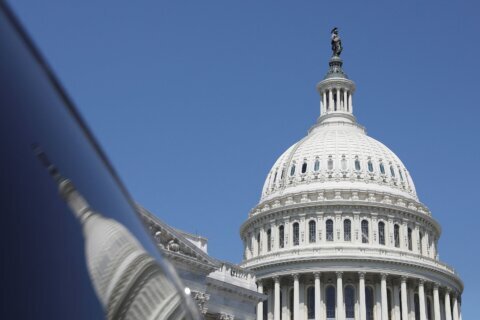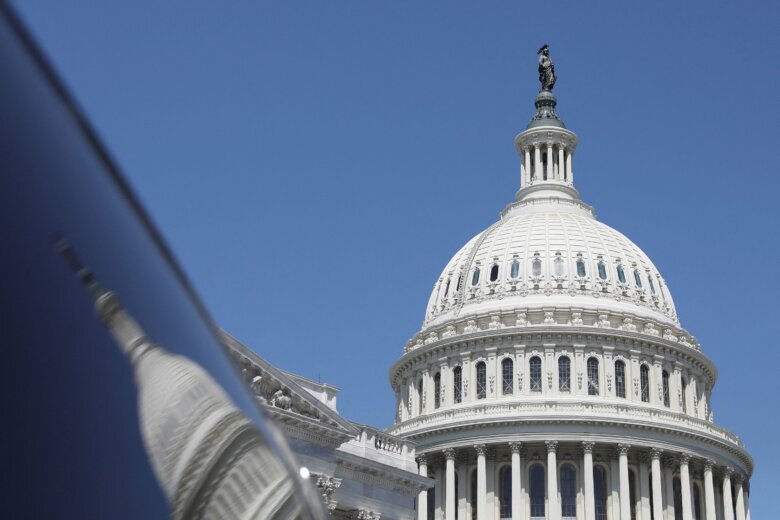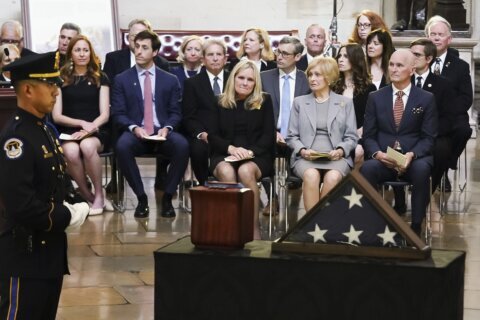
Congress is quickly approaching a pair of government funding deadlines, with less than a week to go before a potential partial shutdown and lawmakers at an impasse with no clear plan in place to avoid it.
On Tuesday, President Joe Biden met with four top congressional leaders at the White House, and later that evening House Speaker Mike Johnson offered to move a short-term spending bill to give negotiators more time to hammer out a longer-term funding deal while avoiding a government shutdown.
Lawmakers had hoped to unveil the text of a bipartisan spending deal Sunday evening, but its release was delayed because of continued disagreements over policy issues.
Senate Majority Leader Chuck Schumer warned Sunday afternoon of the consequences of a shutdown in a “Dear Colleague” letter. Food support for women and children, critical loans to farmers, veteran outreach offices and support, federal housing loan support and the hiring and training of air traffic controllers could all be affected, he said.
The federal government on Friday formally initiated the process of preparing for a potential shutdown, participating in the mandatory-but-standard process of releasing shutdown guidance to agencies ahead of the March 1 funding deadline. That means federal departments and agencies impacted by the first deadline need to update and review their shutdown plans.
If this feels familiar, that’s because this is the fourth time since September that lawmakers have run up against a funding deadline, passing stopgap bills in the nick of time in September, November and once more in January to keep the government running.
In January, lawmakers passed a two-step, short-term funding extension setting up a pair of new deadlines on March 1 and March 8. In the absence of a deal in the coming days on a broader funding package or a short-term stopgap bill, known as a “continuing resolution,” a set of departments will run out of money at the end of Friday, comprising about 20% of the federal government.
The two-step plan passed in January extends funding through March 1 for parts of the federal government including military construction and the departments of Veterans Affairs, Agriculture, Housing and Urban Development, Transportation and Energy. The rest of the government – anything not covered by the first step – is funded through March 8.
While bipartisan, bicameral talks continue, House Republicans remain divided on the best path to keep the government open, with appropriators haggling over conservative policy riders deemed poison pills by Democrats – all setting up another complicated test for Johnson and his narrow majority.
In the meantime, the behind-the-scenes work of preparing for a partial shutdown still has to happen. The standard procedure laying out the steps toward bringing non-essential government functions to a halt will get underway later this week for all federal government departments and agencies – not just those impacted by the March 1 deadline, an administration official told CNN.
“One week prior to the expiration of appropriations bills, regardless of whether the enactment of appropriations appears imminent, OMB will communicate with agency senior officials to remind agencies of their responsibilities to review and update orderly shutdown plans, and will share a draft communication template to notify employees of the status of appropriations,” a document from the White House’s Office of Management and Budget states.
That standard guidance was circulated Friday, seven days before a partial shutdown could occur.
Every department and agency has its own set of plans and procedures. That guidance includes information on how many employees would get furloughed, which employees are essential and would work without pay, how long it would take to wind down operations in the hours before a shutdown and which activities would come to a halt. Those plans can vary from shutdown to shutdown.
The shutdown that would begin early Saturday would affect about 630,000 federal workers, said Rachel Snyderman, director of economic policy at the Bipartisan Policy Center. Roughly 524,000 staffers – mainly at the Department of Veterans Affairs – would continue working without pay, while the rest would be furloughed.
Here are some of the potential impacts of a partial shutdown, as detailed in the latest version of each impacted department’s plans, which are subject to change:
Veterans Affairs
If the government shuts down later this week, the Department of Veterans Affairs is clear that “veteran health care is not impacted,” according to agency policy updated in January. VA benefits, “including compensation, pension, education, and housing benefits,” will also continue during a shutdown. The department, it says, has worked to minimize impacts to those it serves – and estimates that 96% of VA employees “would be fully funded or required to perform excepted functions during a shutdown.”
Still, a number of the department’s functions could stop.
“Our public facing regional offices would be closed and many regular operations like career counseling, transition assistance, and cemetery ground maintenance would not be available,” VA Secretary Denis McDonough warned at a news conference Monday.
The GI Bill Hotline, which veterans can call for support for education and training questions, will cease during a shutdown. And the Transition Assistance Program, a program that helps service members and their families transition from military to civilian life, would stop during a government shutdown.
McDonough also voiced concerns about reaching veterans who are newly eligible for VA health care under the PACT Act, a bill passed in 2022 expanding benefits for veterans exposed to toxic burn pits during their military service.
“We want to be able to reach them to ensure they avail themselves of what they have earned,” McDonough said.
Transportation
Much of the Department of Transportation and its related agencies’ work will continue during a shutdown, including air traffic control, certain safety inspections and accident investigations across modes of transportation. But there could still be travel disruptions as air traffic controllers work without pay. A shutdown will also stall the training of new air traffic controllers who are not yet certified to work, halt any aviation or railway rulemaking and stop any special investigations of hazardous materials through the Pipeline and Hazardous Materials Safety Administration.
Housing and Urban Development
Americans dependent on the Department of Housing and Urban Development to help pay their rent or mortgage could be affected by a government shutdown, depending on how long it lasts.
Most rental assistance programs would be funded using carryover and advance funding through April, according to the agency, which serves more than 4.5 million households through its rental assistance programs.
The agency had roughly 8,600 employees in September, most of whom would be furloughed in a shutdown, according to its September guidance. Some activities will continue, such as the majority of HUD’s annual grant programs, including emergency housing for the homeless, when the grant funding has already been obligated. But there would be very little HUD support or oversight, and new grant funding would not be available.
While the Federal Housing Administration would continue to insure single-family mortgages, it would not be able to insure new reverse mortgages for seniors. The agency would also stop processing new multifamily loan guarantees.
Agriculture
Two of the Department of Agriculture’s main nutrition assistance programs would continue operating for the time being even if the agency’s funding lapses in early March, a USDA spokesperson told CNN. Those enrolled in the Supplemental Nutrition Assistance Program, or SNAP, would receive their food stamp benefits in March, as usual. Also, pregnant women, new moms, infants and young children would continue to receive their WIC benefits in March. (WIC is formally known as the Special Supplemental Nutrition Program for Women, Infants, and Children.)
This differs from what would have happened had the government shut down in October. The USDA said at the time that it did not have sufficient funding to support normal WIC operations beyond a few days into a shutdown – though individual states may have had additional money to continue the program.
Overall, the agency expects it would furlough 59% of its roughly 97,000 staffers in a shutdown, according to its September 2023 guidance. Nearly all the workers in its food safety and inspection service would remain on the job, as would just over half of the staff in its animal and plant health inspection service. But no new rural development loans or grants would be made with discretionary funds, except for emergency purposes.
Energy
The Department of Energy offers broad definitions for what continues – and what stops – during a potential government shutdown. Activities, the guidance states, “not related to the preservation of life and property, unnecessary to the discharge of the President’s constitutional power, not funded by other than annual appropriations, or not otherwise expressly authorized by law will cease.” The guidance does note that if there is only a brief shutdown of five days or less, “no disruption” to Energy Department operations is expected.
This story has been updated with additional developments.
The-CNN-Wire
™ & © 2024 Cable News Network, Inc., a Warner Bros. Discovery Company. All rights reserved.








